 By Hubery Editer
By Hubery Editer
Over the past six years since the One Belt and Road was put forward, many building projects have been supported by the governments alongside and get great development. Recently, Russia government has supported an infrastructure project called the Meridian highway. This toll road connects China's western neighbor, Kazakhstan with Belarus, which is over 2000km. Hence one can see that the increasing demand of building materials results in the increasing demand of mining machines, which is a sign of machinery industry development. There are various machines used in the building materials production. Except for crushers, here introduce another kind of mining machine extensively used in the production upstream, Rotary Dryer.
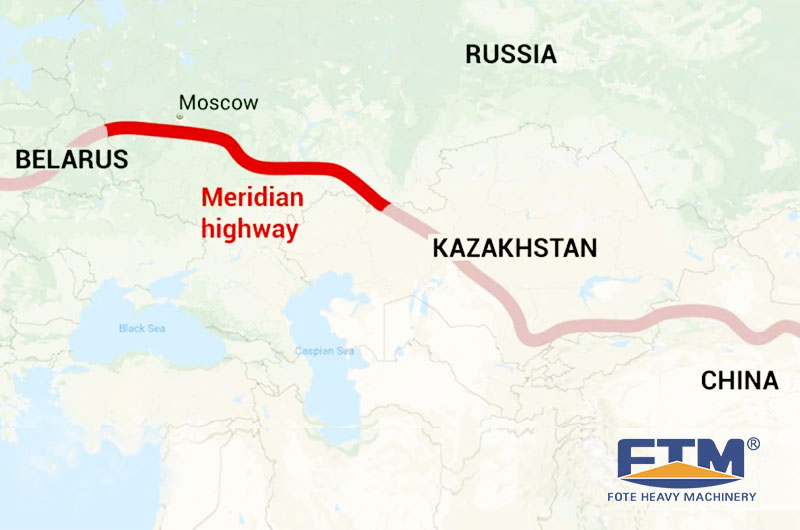
Russia Approves 'Shortes' Europe-China Highway-Reports(via The Moscow Times)
Dewatering plays a key part either in the further processing plant or in product handling. As one kind of dryer machine to reduce the water that introduced into the operation, rotary dryer can be used for many kinds of powder or particles drying like slag, pulverized coal, fly ash, limestone, kaolin, clay, and other materials with a certain moisture that are non-thermal and not easy to explode. It is widely used in building materials, chemical industry, metallurgy industry and so on.
For its drum cylinder structure, rotary dryer is also called rotary drum dryer. According to different structure, rotary dryer is divided into single-cylinder dryer, double-cylinder dryer and three-cylinder dryer. While based on different application, rotary dryer machine can be divided into kaolin dryer, sludge dryer, coal slime dryer, sawdust dryer, fly ash dryer and so on.
Based on the different flow directions of the materials and the scorching wind, there are mainly two types including the downstream flow type and countercurrent type. In the former type of rotary dryer, the direction of materials movement and scorching wind is the same, while in the latter type, materials and the scorchin wind go in an opposite direction.
The burner is set at the feed end and the materials go with the hot wind to the discharge end. At the feed end, wet materials get touch with the scorching wind. Here the drying speed is relatively fast. While at the discharge end, the material has been dried and its temperature rises, which results in a decreasing of the temperature difference between the hot air and the materials. Here the drying rate is relatively slow, which is mainly used to dry a few materials that have not reached the required humidity. In the counterflow dryer, the wet material is fed into the dryer from the feed end, and the combustion chamber is set at the discharge end. The material moves in the reverse direction with the drying medium (hot air or others), and the material is heated and dried during this movement.
In industrial production, downstream flow rotary dryer machine is the mostly used, for which the temperature of the discharged material by it is low enough for transportation. The benefits of the downstream flow rotary dryer are as follows.
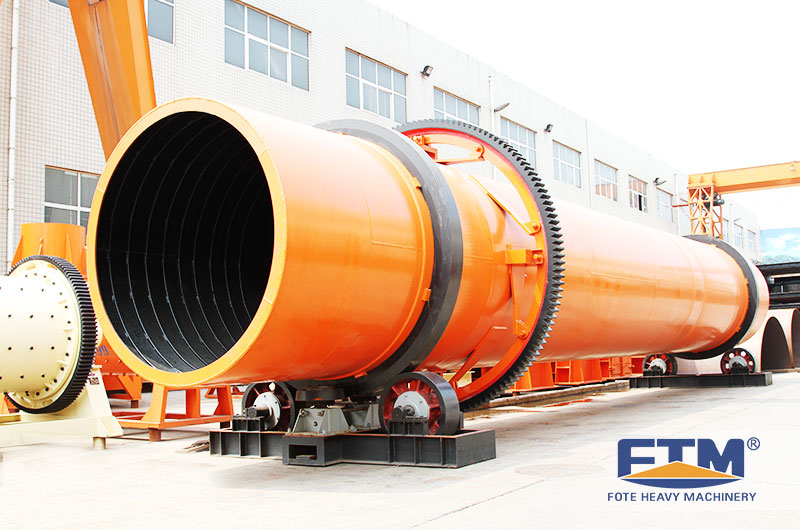
FTM Rotary Dryer
Different kinds of rotary dryers have different working principles. While the rotary dryer is mainly composed of a rotary cylinder, lifting plates, transmission device, bearing device and sealing rings, etc. The rotary dryer machine works based on the principle of heat transmission and on the effect of gravity. The cylinder is rotating and slightly inclined to the horizontal line.
When a rotary dryer works, wet materials are firstly conveyed into the hopper by the belt conveyor. Then the feeder sends the materials into the higher feed end of the cylinder through the feed pipe. The materials falling down form a screen. The fan has begun work and the heat exchange starts. Under the effect of gravity, the materials move forward slowly with the rotating cylinder. In the rotating process, the plates inside lift up the scattered materials. Here, the materials in the air and on the cylinder will get heat from the scorching wind as well as the inner cylinder wall. In addition to the hot wind, heat carriers can be effluent gases and so on. After the heat carrier passes through the dryer, it is generally necessary for the cyclone to collect the material in the gas. If the dust content of tail gas needs to be further reduced, it should be discharged after passing through a bag filter or wet dust collector.
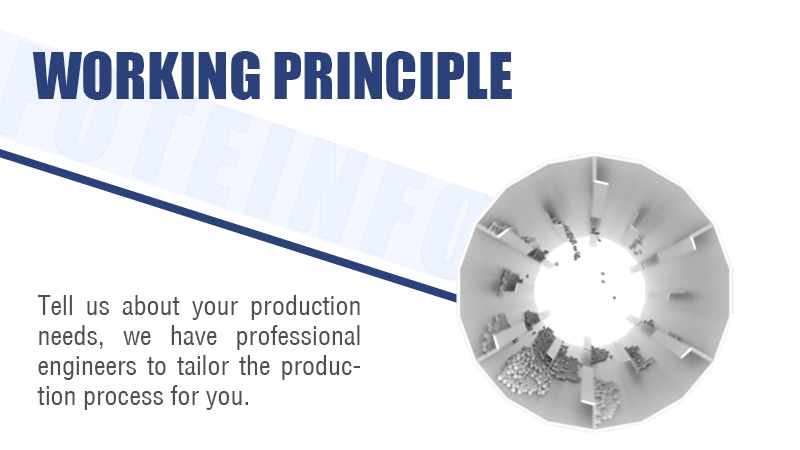
Working Principle of Rotary Dryer
Each type of dryer accessories and parts vary according to customer needs or handling materials. For example, coal slime dryer will be equipped with scattering device based on customer demand because the material, coal slime, is viscous and moisture. While all rotary dryers are mainly composed of cylinder, wheel belt, support device, transmission device, sealing device and so on.
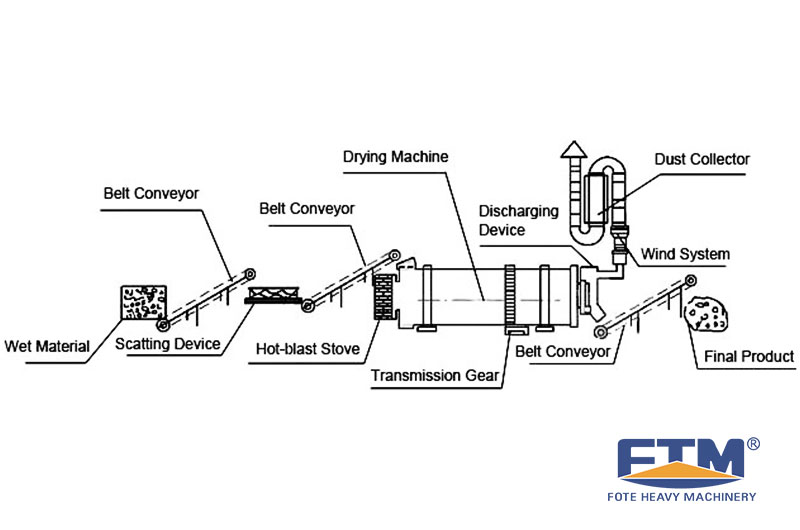
Structure of Rotary Dryer
The part of cylinder is mainly composed of the cylinder itself and the device inside. The cylinder is one kind of rotary drum lying on the bearing device. And the inside device means the lifting plates. In addition to these two main parts, there are striker plate and introduction plate at the feed end to protect the material from spilling. And to protect the cylinder, there sets heat resistant protective plate at the end of burner. As for the function of the lifting plates, they are to enlarge the contact area of material and the scorching wind through the combination of cylinder rotation, thus to improve the heat transmission and the drying efficiency.
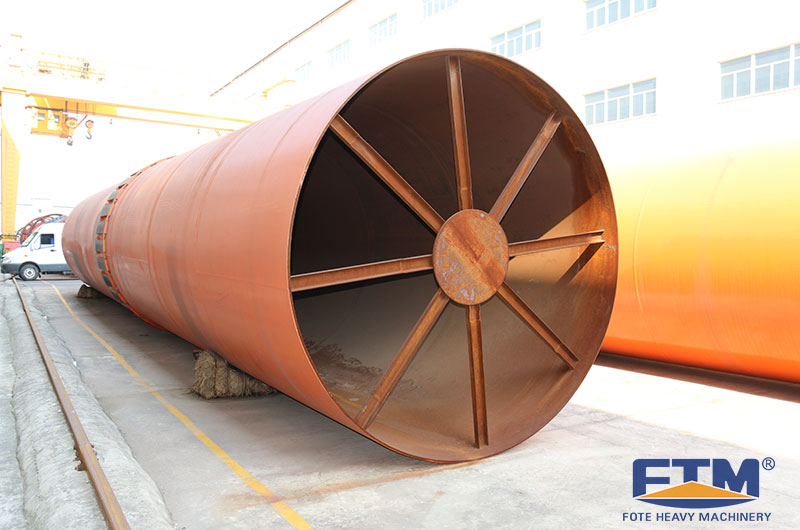
Cylinder of Rotary Dryer
Wheel belt is also called rolling ring, which is made by cast steel turning process. By this process, backing plate, striking device and other components are loop-installed out of the cylinder. The structure and fixed mode are similar to those of rotary kiln. The cylinder has two front and rear roll rings, the function of which is to transfer the weight of the cylinder and material to the supporting device, the supporting wheel. There are many kinds of roll rings structure. The common types are rectangular roll ring, box roll ring, split roller ring and the combination of roller ring and cylinder body. The most commonly used is the last one. This structure combines the roller and the thickening section of the cylinder, strengthens the rigidity of the cylinder, and eliminates the wear problem between the roller and the gasket and the baffle.
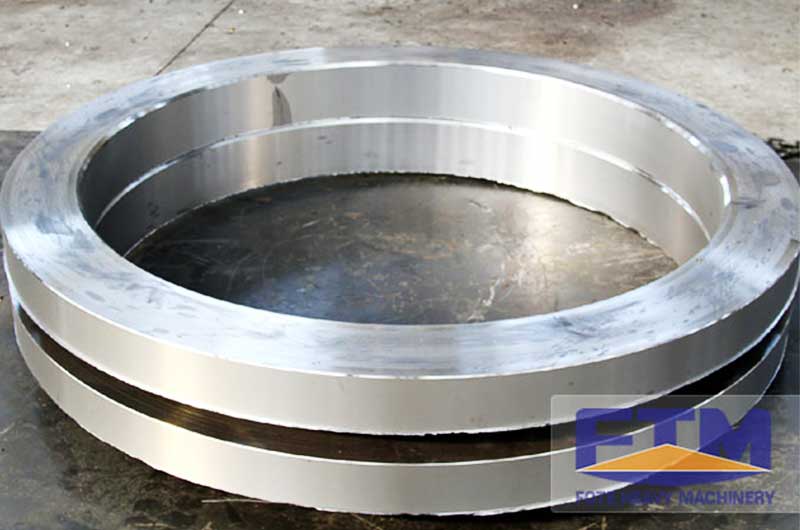
Rotating Ring of Rotary Dryer
The transmission device is used to drive the rotary dryer to rotate, which is the key part of the machine. According to its design requirements, the motor, transmission mode, reducer type and so on must be appropriate, so that the transmission device can achieve Max. optimization, reduce energy consumption and cost. Rotating dryers are slow, so you have to slow down when you click to pass the torque to the cylinder. The speed of deceleration is relatively large. The motor drives the cylinder through the pinions on the output shaft of the reducer and then transmits it to the large gear ring installed on the cylinder body.
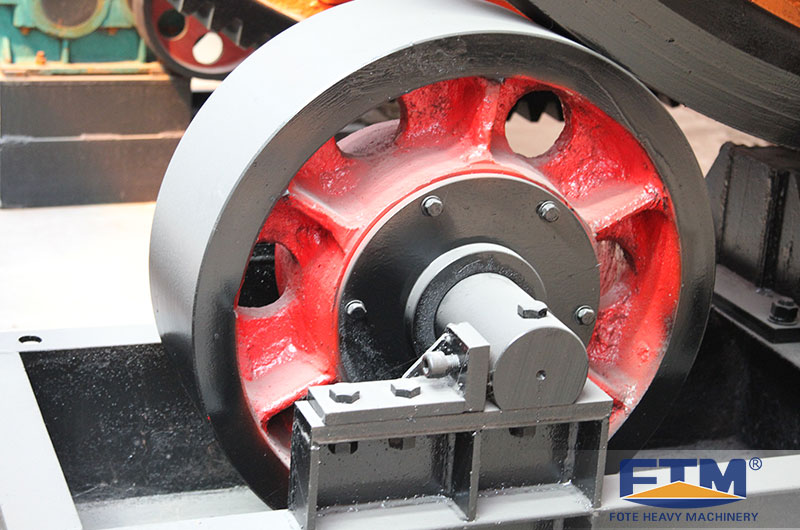
Transmission Device of Rotary Dryer
The sealing device between the drying furnaces plays a rather important role in the feeding process. There will inevitably be a gap in the connection between the rotating cylinder and the fixing device. In order to further prevent the external air from entering the cylinder, ensure the drying efficiency, and avoid external material pollution of the material in the cylinder, it is necessary to set up a sealing device.
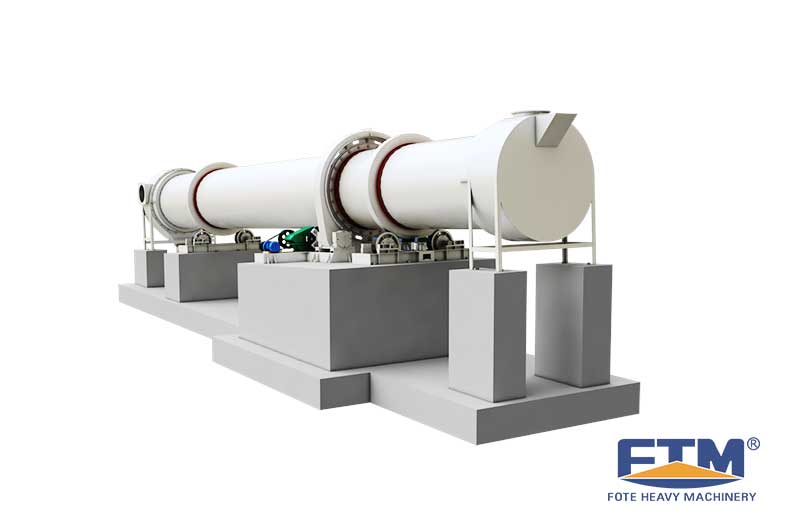
Lookout of Rotary Dryer Sealing Device
According to the different materials, the rotary dryer can be divided into many types. While to dry different materials, the dryer also needs to set different medium temperature. Inappropriate medium temperature will burn out the metal of the rotary dryer, destroy the structure of the material and change the physical properties.
| Material | Bituminous Coal | Anthracite | Clay | Slag | Limestone |
| Temperature of Heat Carrier(℃) | 400-700 | 500-700 | 600-800 | 700-800 | 800-1000 |
| Temperature of Belched Air(℃) | 90-120 | 90-120 | 80-110 | 100-150 | 100-150 |
| Temperature of Discharged Material(℃) | 60-90 | 60-90 | 80-100 | 80-100 | 100-120 |
| Air Flow Rate in the Outset(m/s) | 1.5-3 | 1.5-3 | 1.5-3 | 1.5-3 | 1.5-3 |
Table of Some Processing Specifications of Part of Materials
Taking these two widely used coal slime dryer and slag dryer as examples, here briefly introduces the difference of structural accessories and working principle between different dryers.
Because the coal slime has the features of large humidity, stickiness and high WHC (Water Holding Capacity). In the drying process, the caked slime is easy to cling onto the inner wall of the cylinder, which affects the forward movement of the material and leads to the result that part of coal slime cannot be fully dried. In addition, it is very inconvenient to clean up the dryer after the process. While the dried coal slime is of high economic value and can be used for many industrial purposes. However, because of the increasing coal production, the coal slime production increases obviously. The slime dryer plays an extremely important role in the recycling of coal slime.
The difference between coal slime dryer and general dryer is that it is necessary to deal with slime which is easy to bond at the feed port. Therefore, it should be equipped with dispersing device and rotary cutting machine. When the dispersed slime enters the dryer, the crushing device of the drum is used to prevent the slime from caking on the inner wall. It can improve drying efficiency, lower energy consumption and reduce cost.
Slag is produced in blast furnace steelmaking. For example, to make each ton of steel, about 12% slag will be produced. The treated slag can be used as ironmaking raw materials, highway roadbed, railway roadbed or cement raw material. Because of the different size of slag, in order to increase the drying rate of the material, it is necessary to break or crush or grind the slag before entering the cylinder. The ball mill can be used for crushing and grinding. The combustion chamber is generally equipped with "air-smoke" mixing type to improve drying efficiency.
Rotary dryer can be widely used in mineral processing production line, grinding production line, particle production line, cement production line and gypsum production line, etc. For different plant demands, the dryer configuration and parameters will also be different. The selection of dryer is generally related to production capacity, initial humidity, required discharge humidity and material type. According to customer needs, manufacturers can generally provide customized solutions. For more information, you can consult our engineers online or leave a message. Our engineers are ready to offer free consultation service including rotary price and its selection.
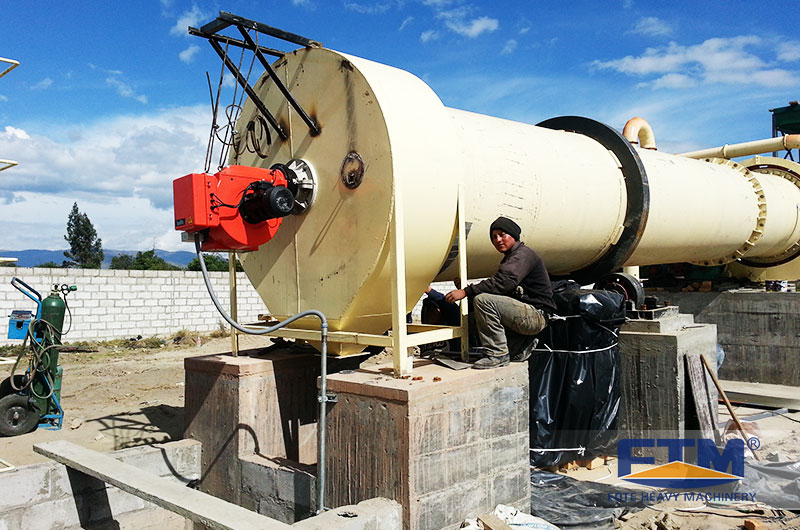
FTM Rotary Dryer at Customer Site
 Online Chat
Online Chat